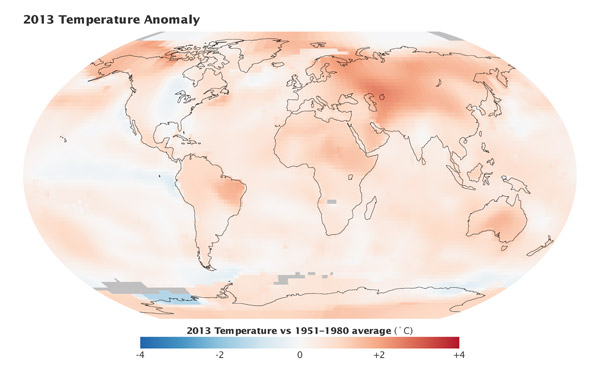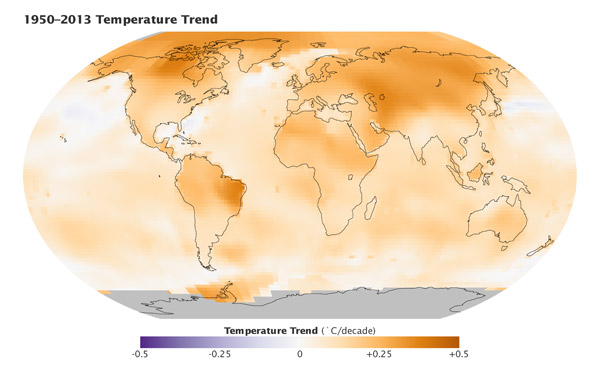Global warming continues apace as 2013 was the seventh warmest year in the past 133 years, according to a new analysis from NASA’s Goddard Institute for Space Studies (GISS). In total, the global temperature in 2013 averaged 14.6 degrees Celsius (58.3 degrees Fahrenheit), or 0.6 degrees Celsius (1.1 degrees Fahrenheit) hotter than the 20th Century average.
“2013 adds to the evidence for ongoing climate change,” said Gavin Schmidt, a climatologist with NASA. “While one year or one season can be affected by random weather events, this analysis shows the necessity for continued, long-term monitoring.”
A new map released by NASA GISS shows that warming was particularly acute (as compared to average temperatures from 1951-1980) in the Arctic, Central Asia, Australia (which had its warmest year on record), and Brazil. Few regions were cooler than average, but parts of the Eastern U.S., coastal Antarctica, and the western Pacific were slightly cooler. Interestingly, much of U.S. was an exception last year for being relatively cool: it was the 42nd warmest year on record for the continental U.S.
Globally, the warmest years on record to date are 2010 and 2005, according to NASA. The Earth hasn’t experienced a below average year in almost forty years.
Burning fossil fuels for energy is the primary cause of ongoing climate change, compounded by deforestation and industrial agriculture. Scientists have long warned that the world will need to quickly wean itself off fossil fuels if we are to avoid catastrophic climate change, but governments continue to move slowly to address the crisis.

2013 temperatures as compared to a 1951-1980 baseline. Map courtesy of NASA. Click to enlarge.

Warming over the Earth from 1951 to 2013. Map courtesy of NASA. Click to enlarge.
Related articles
Underestimating global warming: gaps in Arctic temperature data lead scientists and public astray

(01/15/2014) No place on Earth is heating up faster than the Arctic, but just how fast has remained an open question due to large gaps in temperature data across the vast region. Now, a recent study in the Quarterly Journal of the Royal Meteorological Society finds that not only is the Arctic warming eight times faster than the rest of the planet, but failure to account for temperature gaps has led global datasets to underestimate the rise of temperatures worldwide.
Carbon emissions rise 2 percent in U.S. due to increase in coal
(01/14/2014) Carbon dioxide emissions rose two percent in the U.S. last year, according to preliminary data from the Energy Information Administration. Emissions rose largely due to increased coal consumption, the first such rise in U.S. emissions since 2010. Still, the annual emissions remain well below the peak hit in 2007 when emissions hit 6 billion tons.
Climate fail: Geoengineering would cool planet, but screw up rainfall patterns

(01/14/2014) For decades, scientists have been grappling with the consequences of climate change and working toward viable solutions. Climate engineering, also known as geoengineering, is the most controversial possible solution. Currently, one of the most talked about geoengineering ideas is Solar Radiation Management (SRM), which intends to block shortwave solar radiation, thus cooling the Earth to offset rising temperatures. In other words, SRM may be one way in which global temperatures could be artificially stabilized.
Down Under scorching: Australia experiences warmest year on record
(01/06/2014) Australia had its warmest year on record, with annual temperatures 1.2 degrees Celsius (2.16 degrees Fahrenheit) above the 1961-1990 average, according to a new analysis from Australia’s Bureau of Meteorology (BOM). This is 0.5 degrees Celsius higher than the previous warmest year on record—2005—for Australia. Global warming due to burning fossil fuels is increasing temperatures worldwide.
Global warming could upset Antarctic food chain

(01/02/2014) Resting near the bottom of the foodchain, Antarctic krill (Euphausia superba) underpin much of the Southern Ocean’s ecosystem. But in a rapidly warming world, these hugely-abundant crustaceans could see their habitat shrink considerably. In a recent paper in PLOS ONE, scientists predict that Antarctic krill could lose 20 percent of their growth habitat, or 1.2 million square kilometers.
Climate change drives Florida mangroves northward
(12/30/2013) A decline in the frequency of extreme cold weather in Florida has allowed coastal mangrove forests to expand northward, finds a study published this week in Proceedings of the National Academy of Sciences.